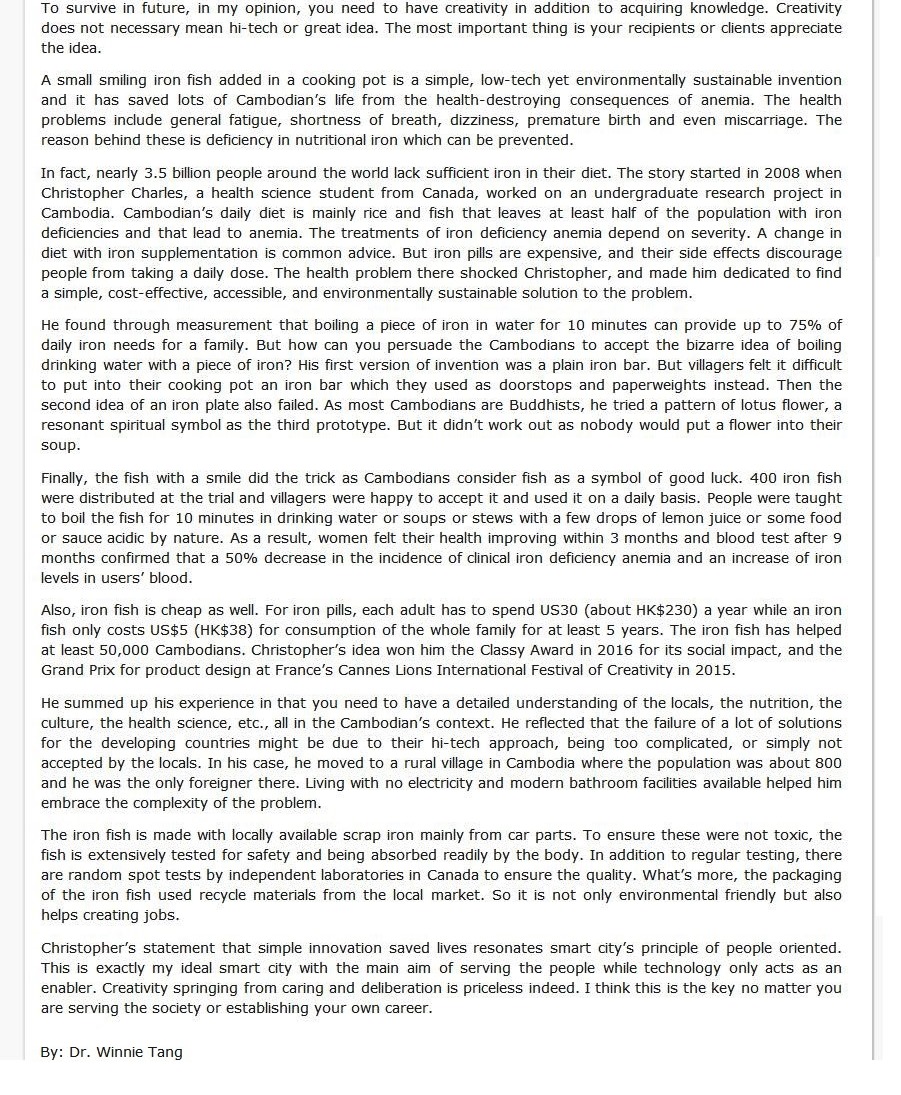網上版請按此


Priceless Creativity
During our school days when parents' only concern was whether their kids did well at school, no one talked about creativity. To be able of becoming respected professionals like doctors, engineers, accountants or lawyers was the mainstream life expectation. This was particular the case in Asia. It is, however, about to change–some 10 years ago, Facebook was launched while WhatsApp was nowhere to be seen. Now, almost everybody cannot do without them for both work and daily life. Today, public media frequently mention how artificial intelligent would one day replace human beings who would then be left jobless. Last year, Goldman Sachs replaced off 600 traders with computer programs. Who knows what will happen 10 years on!
To survive in future, in my opinion, you need to have creativity in addition to acquiring knowledge. Creativity does not necessary mean hi-tech or great idea. The most important thing is your recipients or clients appreciate the idea.
A small smiling iron fish added in a cooking pot is a simple, low-tech yet environmentally sustainable invention and it has saved lots of Cambodian's life from the health-destroying consequences of anemia. The health problems include general fatigue, shortness of breath, dizziness, premature birth and even miscarriage. The reason behind these is deficiency in nutritional iron which can be prevented.
In fact, nearly 3.5 billion people around the world lack sufficient iron in their diet. The story started in 2008 when Christopher Charles, a health science student from Canada, worked on an undergraduate research project in Cambodia. Cambodian's daily diet is mainly rice and fish that leaves at least half of the population with iron deficiencies and that lead to anemia. The treatments of iron deficiency anemia depend on severity. A change in diet with iron supplementation is common advice. But iron pills are expensive, and their side effects discourage people from taking a daily dose. The health problem there shocked Christopher, and made him dedicated to find a simple, cost-effective, accessible, and environmentally sustainable solution to the problem.
He found through measurement that boiling a piece of iron in water for 10 minutes can provide up to 75% of daily iron needs for a family. But how can you persuade the Cambodians to accept the bizarre idea of boiling drinking water with a piece of iron? His first version of invention was a plain iron bar. But villagers felt it difficult to put into their cooking pot an iron bar which they used as doorstops and paperweights instead. Then the second idea of an iron plate also failed. As most Cambodians are Buddhists, he tried a pattern of lotus flower, a resonant spiritual symbol as the third prototype. But it didn’t work out as nobody would put a flower into their soup.
Finally, the fish with a smile did the trick as Cambodians consider fish as a symbol of good luck. 400 iron fish were distributed at the trial and villagers were happy to accept it and used it on a daily basis. People were taught to boil the fish for 10 minutes in drinking water or soups or stews with a few drops of lemon juice or some food or sauce acidic by nature. As a result, women felt their health improving within 3 months and blood test after 9 months confirmed that a 50% decrease in the incidence of clinical iron deficiency anemia and an increase of iron levels in users' blood.
Also, iron fish is cheap as well. For iron pills, each adult has to spend US30 (about HK$230) a year while an iron fish only costs US$5 (HK$38) for consumption of the whole family for at least 5 years. The iron fish has helped at least 50,000 Cambodians. Christopher's idea won him the Classy Award in 2016 for its social impact, and the Grand Prix for product design at France's Cannes Lions International Festival of Creativity in 2015.
He summed up his experience in that you need to have a detailed understanding of the locals, the nutrition, the culture, the health science, etc., all in the Cambodian's context. He reflected that the failure of a lot of solutions for the developing countries might be due to their hi-tech approach, being too complicated, or simply not accepted by the locals. In his case, he moved to a rural village in Cambodia where the population was about 800 and he was the only foreigner there. Living with no electricity and modern bathroom facilities available helped him embrace the complexity of the problem.
The iron fish is made with locally available scrap iron mainly from car parts. To ensure these were not toxic, the fish is extensively tested for safety and being absorbed readily by the body. In addition to regular testing, there are random spot tests by independent laboratories in Canada to ensure the quality. What's more, the packaging of the iron fish used recycle materials from the local market. So it is not only environmental friendly but also helps creating jobs.
Christopher's statement that simple innovation saved lives resonates smart city's principle of people oriented. This is exactly my ideal smart city with the main aim of serving the people while technology only acts as an enabler. Creativity springing from caring and deliberation is priceless indeed. I think this is the key no matter you are serving the society or establishing your own career.
Dr. Winnie Tang
Honorary Professor, Department of Computer Science, The University of Hong Kong